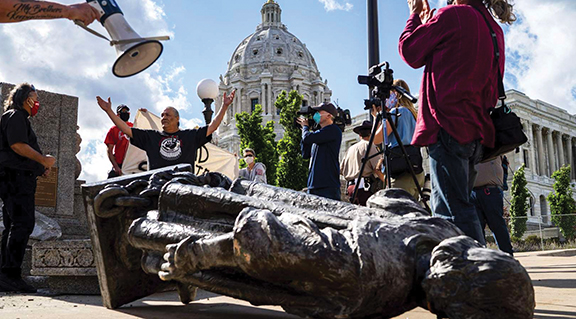
By Winona LaDuke
“Historian Here: Tearing down a statue is not erasing history. Putting up a statue on land whose original caretakers you can’t name is.”
– Nick Estes, Lakota Historian.
Across the country statues of empire are tumbling. The idols are indeed falling, the American idols that is. This is not just about statutes. It is about whose history is celebrated, the history of the oppressor, or the history of the oppressed. It looks like it may be time for a reconciliation.
George Floyd’s death has been the spark of an international movement for human rights and dignity. That spark is seen across the world, and it means that some big statues are coming down. The toppling of the Columbus statue in St. Paul by the American Indian Movement (AIM) leaders was one of many nationally, and the statue toppling has also included some conquistadors. I predict that before we are done a whole bunch of Confederate leaders, some Indian War generals, and some corrupt and genocide complicit governors will also fall. And, it’s about time.
Heads are gonna roll. A Columbus statue was beheaded in Boston, one was removed in Richmond (landing in a lake) and on the June 25 Anniversary of the Little Big Horn, the Columbus statue came down in Denver. That’s after decades of opposition to the City’s proud Columbus Day celebrations. “… The statue was found on its side on the sidewalk Friday morning…” the Denver Post reported.
There should be a way to have this discussion in civil society. But what this spring has taught us is that if the system doesn’t work, and people keep trying to make change, something’s going to give. Now there’s supposed to be a process for removing statues in Minnesota. There’s a board called the CAAP (Capitol Area Architectural and Planning Board) and Lt. Gov. Peggy Flanagan (Ojibwe) chairs the CAAP board. However, the CAAP board has not removed a single statue in 52 years. That might need to change.
Flanagan had to face reporters after the statue came down, this time by the hands of Mike Forcia, an Ojibwe businessman, community leader and member of AIM.
“I’m not going to perform for folks. I’m not gonna feign sadness. I’m not gonna shed a tear over the loss of a statue that honored someone who by of his own admission sold 9- and 10-year-old girls over sex slavery,” Flanagan said at a news conference. This is a new Minnesota.
They are Falling
Other colonizers are falling as well. Juan De Onate, a conquistador who become the Governor of New Mexico in l598, was a brutal man. When his troops needed food, he demanded it of Acoma Pueblo, and when the Pueblo refused and fought back, Onate ordered the massacre of 800 Acoma people. He also ordered the amputation of the right foot of any adult Acoma man in the village; 24 of them in total. They lived the rest of their lives with stumps. Oñate was recalled to Mexico City in 1606 to account for his conduct, where he was convicted of cruelty to both Natives and colonists and banished from New Mexico for life.
He lived on, however, as a statue. Mounted on a horse, the conquistador wore military regalia and loomed large on Highway 68, out of Santa Fe. On the eve of the 400th anniversary of Onate’s arrival into the region, December l997 someone sawed off Onate’s right foot and left a note saying, “Fair is fair.” This June, that statue came down.
Red Nation, an Indigenous youth group, organized a demonstration at the Onate statue. Sensing that Onate’s time had come, officials removed the statue for safe keeping. “It’s a win,” said Luis Pena, who started a petition to remove the statue and stood near the concrete platform covered with blood-red handprints. “Symbols are important, they shape the way we ingest the world … In reclaiming these symbols, we get a chance to tell a side of history that has been left out of the books.”
Another Onate statue came down in Albuquerque, and now Kit Carson is in question everywhere. Carson, who has National Forests, squares, and more named in his honor, burned the orchards of the Navajo and forced them on the Long Walk to Fort Redondo, many did not return.
Reporter Randall Balmer told a sweet story for the LA Times: “For the first time in many years, we don’t have to stare at Oñate,” Elena Ortiz, a Red Nation leader, told the Santa Fe New Mexican. “The presence of that statue was an act of violence upon Pueblo people from the moment it was put up and now, finally, it’s gone.”
When Than Tsídéh, whose name means Sun Bird in the Tewa language, arrived at the Oñate monument, the statue of the Pueblos’ tormentor was already gone.
“I started to sing,” he explained, “in honor of my ancestors who I know were slaughtered by this man.” And then Than Tsídéh did what his long-ago ancestors, (because of Onate’s cynical brutality) could not. He danced.
Over the past month, NASCAR has banned confederate flags, and the confederate statues are falling. Where do 700 confederate statues go? That’s a good question being asked nationally, and one which we should begin to ask in Minnesota. After all, we should have learned by now that glorifying genocide in art is a bad idea; just take the Walker Art Center’s installation of Sam Durant’s sculpture Scaffold in 2012. The idea that Minnesota institutions can glorify genocide is problematic, and as statutes tumble across the world, now is a good time to figure out the next art installations.
I believe that the Walker Art Center replaced the Scaffold with a giant blue chicken. Really, they could have done something monumental, like pay a comparable commission to what they paid Durant to a Native Artist. Our art is beautiful. Let’s replace Columbus with an Indigenous person.
My suggestion for the fallen idols is maybe a Statue Garden of Shame. It could be a learning exercise, sort of like looking at old statues or pictures of Hitler. Don’t keep that stuff around, it’s bad karma.
And for Minnesota, there’s a pretty decent list of folks who might need to take a hike to a new garden spot. I’d like to put Knute Nelson right there on top of that list. Nelson was responsible for the death, misery and theft of the lands of White Earth Anishinaabe people and went on to become governor. Sort of like Onate, but without the massacres. Our deaths took a couple of generations. His statue stands tall at the capital. Let’s use this opportunity to make a new story, bring forth new art and dance together.






